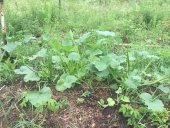I recommend looking into hugelkuture (or "hugel") beds if you have any woody debris or other
carbon rich organic material freely available. Basically:
- 1/3 of a hugelkulture bed is
wood layered thinly with
native soil (usually topsoil from the adjacent path)
- ideally this topped with 2-6" of
compost or more. It can be just native soil but that will take longer to improve.
The first year, growth will be about as good as a similar wood free raised bed with similar soil. The second year, the hugel bed will grow significantly better, and after the third year I bet most people will replace the old beds with hugels because its no comparison for tilth, growth, disease resistance, drainage, and water retention/drought mitigation. They even extend the season for me by biologically warming the soil and improving drainage in the spring
enough to see growth a couple weeks earlier than standard raised beds.
The taller the bed, the longer one can forego watering. A 6ft bed could go 6 hot months without water by its 3rd year. A 2ft tall bed can go a month when non hugels need water every week. The wood acts as the water resevoir, hosts beneficial fungi that supply nutrients to plants and hold more water, and leads to a more diverse and abundant soil ecosystem. I have used wicking beds, and have tried integrating wicking subterranean irrigation into hugels, but ultimately think its not worth the trouble in most cases for me. I use dripline covered in mulch instead. I have however intalled perforated 4" pipe for drainage in places where hugels lie near contour on steep slopes below hardscapes (roads or rooves) that drain a lot of water. Especially in the first season, if a hugel is unwisely placed like a dam in the path of water, wood can float and become hazardous flotsom (or is it jetsom?). Well enough of that tangent away from the topic of this
thread!
Whatever you try, best of luck!






 1
1




 2
2




 1
1











































